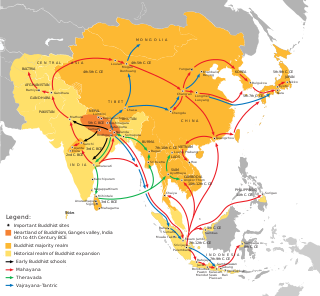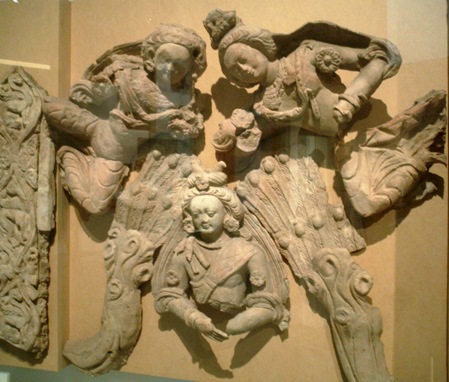
The Silk Road was and is a network of trade routes connecting the East and West, from the 2nd century BCE to the 18th century CE. It was central to the economic, cultural, political, and religious interactions between these regions. "The Silk Road" usually refers to certain land routes, but it may also refer to sea routes that connect East Asia and Southeast Asia with South Asia, Persia, the Arabian Peninsula, the Near East, East Africa and Southern Europe.

The Mogao Caves, also known as the Thousand Buddha Grottoes or Caves of the Thousand Buddhas, form a system of 500 temples 25 km (16 mi) southeast of the center of Dunhuang, an oasis located at a religious and cultural crossroads on the Silk Road, in Gansu province, China. The caves may also be known as the Dunhuang Caves; however, this term is also used as a collective term to include other Buddhist cave sites in and around the Dunhuang area, such as the Western Thousand Buddha Caves, Eastern Thousand Buddha Caves, Yulin Caves, and Five Temple Caves. The caves contain some of the finest examples of Buddhist art spanning a period of 1,000 years. The first caves were dug out in AD 366 as places of Buddhist meditation and worship. The Mogao Caves are the best known of the Chinese Buddhist grottoes and, along with Longmen Grottoes and Yungang Grottoes, are one of the three famous ancient Buddhist sculptural sites of China.

Greco-Buddhism, or Graeco-Buddhism, is the cultural syncretism between Hellenistic culture and Buddhism, which developed between the fourth century BCE and the fifth century CE in Bactria and the Gandhara. It was a cultural consequence of a long chain of interactions begun by Greek forays into India from the time of Alexander the Great. The Macedonian satraps were then conquered by the Mauryan Empire, under the reign of Chandragupta Maurya. The Mauryan Emperor Ashoka would convert to Buddhism and spread the religious philosophy throughout his domain, as recorded in the Edicts of Ashoka.
The term Serindia combines Seres (China) and India to refer to the part of Asia also known as Sinkiang, Chinese Turkestan or High Asia. See main entry under Xinjiang.

The Kingdom of Khotan was an ancient Iranian Saka Buddhist kingdom located on the branch of the Silk Road that ran along the southern edge of the Taklamakan Desert in the Tarim Basin. The ancient capital was originally sited to the west of modern-day Hotan at Yotkan. From the Han dynasty until at least the Tang dynasty it was known in Chinese as Yutian. This largely Buddhist kingdom existed for over a thousand years until it was conquered by the Muslim Kara-Khanid Khanate in 1006, during the Islamicisation and Turkicisation of Xinjiang.

The Greco-Buddhist art or Gandhara art of the north Indian subcontinent is the artistic manifestation of Greco-Buddhism, a cultural syncretism between Ancient Greek art and Buddhism.

Kucha, or Kuche, was an ancient Buddhist kingdom located on the branch of the Silk Road that ran along the northern edge of the Taklamakan Desert in the Tarim Basin and south of the Muzat River.
The history of Buddhism spans from the 6th century BCE to the present. Buddhism arose in Ancient India, in and around the ancient Kingdom of Magadha, and is based on the teachings of the ascetic Siddhārtha Gautama. The religion evolved as it spread from the northeastern region of the Indian subcontinent throughout Central, East, and Southeast Asia. At one time or another, it influenced most of Asia.

Buddhism entered Han China via the Silk Road, beginning in the 1st or 2nd century CE. The first documented translation efforts by Buddhist monks in China were in the 2nd century CE via the Kushan Empire into the Chinese territory bordering the Tarim Basin under Kanishka. These contacts transmitted strands of Sarvastivadan and Tamrashatiya Buddhism throughout the Eastern world.

The Guimet Museum, full name in French: Musée national des arts asiatiques-Guimet (MNAAG), abbreviated to Musée Guimet, is an art museum located at 6, place d'Iéna in the 16th arrondissement of Paris, France. Literally translated into English, its full name is the National Museum of Asian Arts-Guimet, or Guimet National Museum of Asian Arts.

Many artistic influences transited along the Silk Road, especially through the Central Asia, where Hellenistic, Iranian, Indian and Chinese influence were able to interact. In particular Greco-Buddhist art represent one of the most vivid examples of this interaction. As shown on the 1st century CE Silk Road map, there is no single road but a whole network of long-distance routes: mainly two land routes and one sea route.

Buddhist art is the artistic practices that are influenced by Buddhism. It includes art media which depict Buddhas, bodhisattvas, and other entities; notable Buddhist figures, both historical and mythical; narrative scenes from the lives of all of these; mandalas and other graphic aids to practice; as well as physical objects associated with Buddhist practice, such as vajras, bells, stupas and Buddhist temple architecture. Buddhist art originated on the Indian subcontinent following the historical life of Siddhartha Gautama, 6th to 5th century BCE, and thereafter evolved by contact with other cultures as it spread throughout Asia and the world.

The Subashi Temple is a ruined Buddhist temple near Kucha in the Taklamakan Desert, on the ancient Silk Road, in Xinjiang, Western China. The city was partly excavated by the Japanese archaeologist Count Otani.

Buddhism in Central Asia refers to the forms of Buddhism that existed in Central Asia, which were historically especially prevalent along the Silk Road. The history of Buddhism in Central Asia is closely related to the Silk Road transmission of Buddhism during the first millennium of the common era.

Miran is an ancient oasis town located on the southern rim of the Taklamakan Desert in Xinjiang, Northwest China. Located where the Lop Nur desert meets the Altun Shan mountains, Miran was once a stop on the famous trade route known as the Silk Road. Two thousand years ago a river flowed down from the mountain and Miran had a sophisticated irrigation system. Now the area is a sparsely inhabited, dusty region with poor roads and minimal transportation. Archaeological excavations since the early 20th century have uncovered an extensive Buddhist monastic site that existed between the 2nd to 5th centuries AD, as well as the Miran fort, a Tibetan settlement during the 8th and 9th centuries AD.

The Shorchuk or Qigexing Temple is a ruined compound of Buddhist sites located about 25–30 km southwest of the town of Karasahr, Yanqi Hui Autonomous County, Xinjiang, China. The site was a major religious center along the northern route of the Silk Road in the second half of the first millennium CE. Another name for the site is Ming-oi.

Central Asian art is visual art created in Central Asia, in areas corresponding to modern Kyrgyzstan, Kazakhstan, Uzbekistan, Turkmenistan, Azerbaijan, Tajikistan, Afghanistan, Pakistan, and parts of modern Mongolia, China and Russia. The art of ancient and medieval Central Asia reflects the rich history of this vast area, home to a huge variety of peoples, religions and ways of life. The artistic remains of the region show a remarkable combinations of influences that exemplify the multicultural nature of Central Asian society. The Silk Road transmission of art, Scythian art, Greco-Buddhist art, Serindian art and more recently Persianate culture, are all part of this complicated history.

Rawak is a Buddhist stupa located on the southern rim of the Taklamakan Desert in Xinjiang, China, along the famous trade route known as the Silk Road in the first millennium Kingdom of Khotan. Around the stupa there are other smaller structures which were originally decorated with a large number of colossal statues. The courtyard of the temple was surrounded by a wall, which contained terracotta relieves and some wall-paintings. The stupa and other structures form a three-dimensional mandala. The site is now about 40 km north of the modern city of Hotan in Xinjiang Autonomous Region of the People's Republic of China.

Gandhāran Buddhism refers to the Buddhist culture of ancient Gandhāra which was a major center of Buddhism in the Indian subcontinent from the 3rd century BCE to approximately 1200 CE. Ancient Gandhāra corresponds to modern day north Pakistan, mainly the Peshawar valley and Potohar plateau as well as Afghanistan's Jalalabad. The region has yielded the Gandhāran Buddhist texts written in Gāndhārī Prakrit the oldest Buddhist manuscripts yet discovered. Gandhāra was also home to a unique Buddhist artistic and architectural culture which blended elements from Indian, Hellenistic, Roman and Parthian art. Buddhist Gandhāra was also influential as the gateway through which Buddhism spread to Central Asia and China.

Tepe Sardar, also Tapa Sardar or Tepe-e-Sardar, is an ancient Buddhist monastery in Afghanistan. It is located near Ghazni, and it dominates the Dasht-i Manara plain. The site displays two major artistic phases, an Hellenistic phase during the 3rd to 6th century CE, followed by a Sinicized-Indian phase during the 7th to 9th century.






















